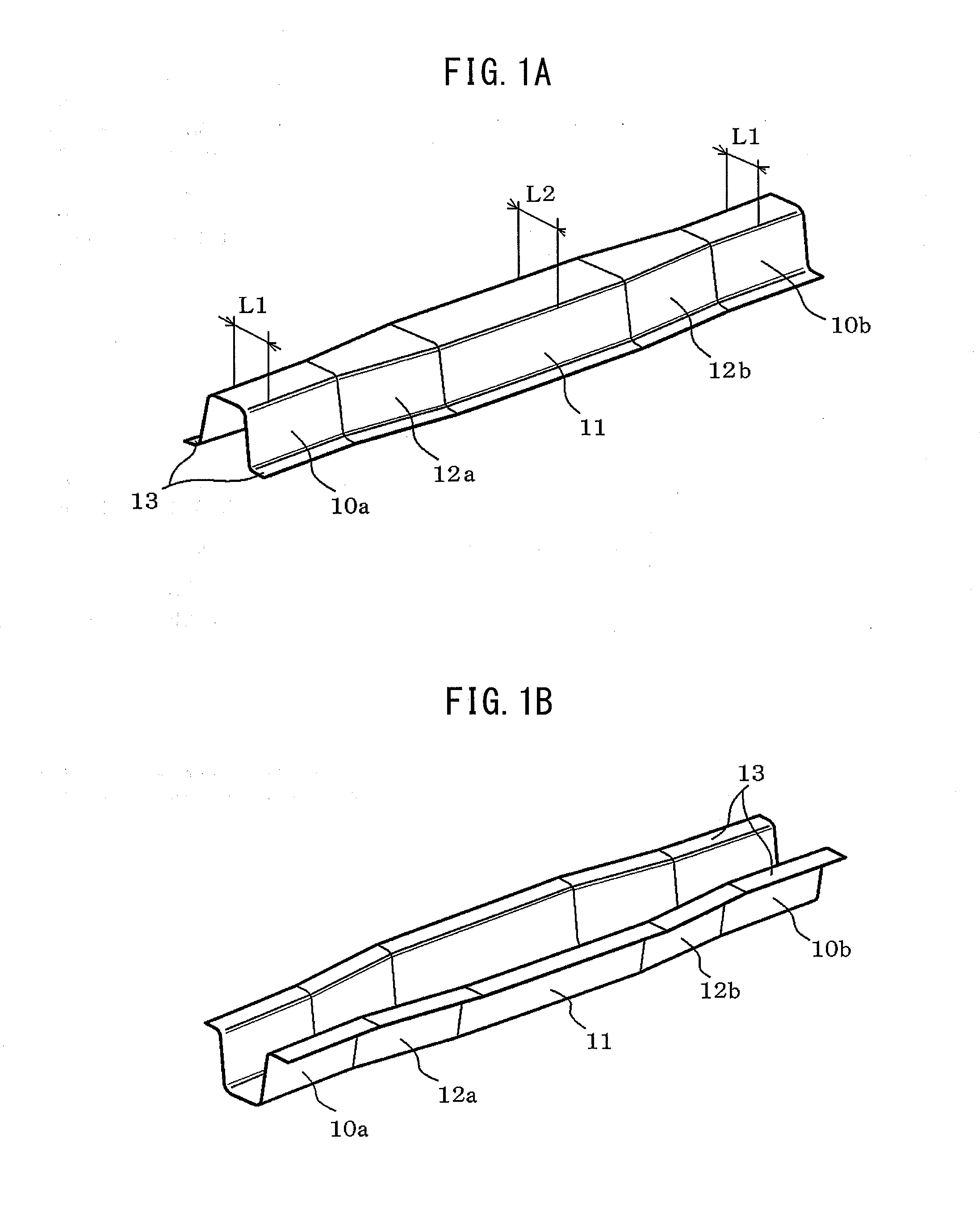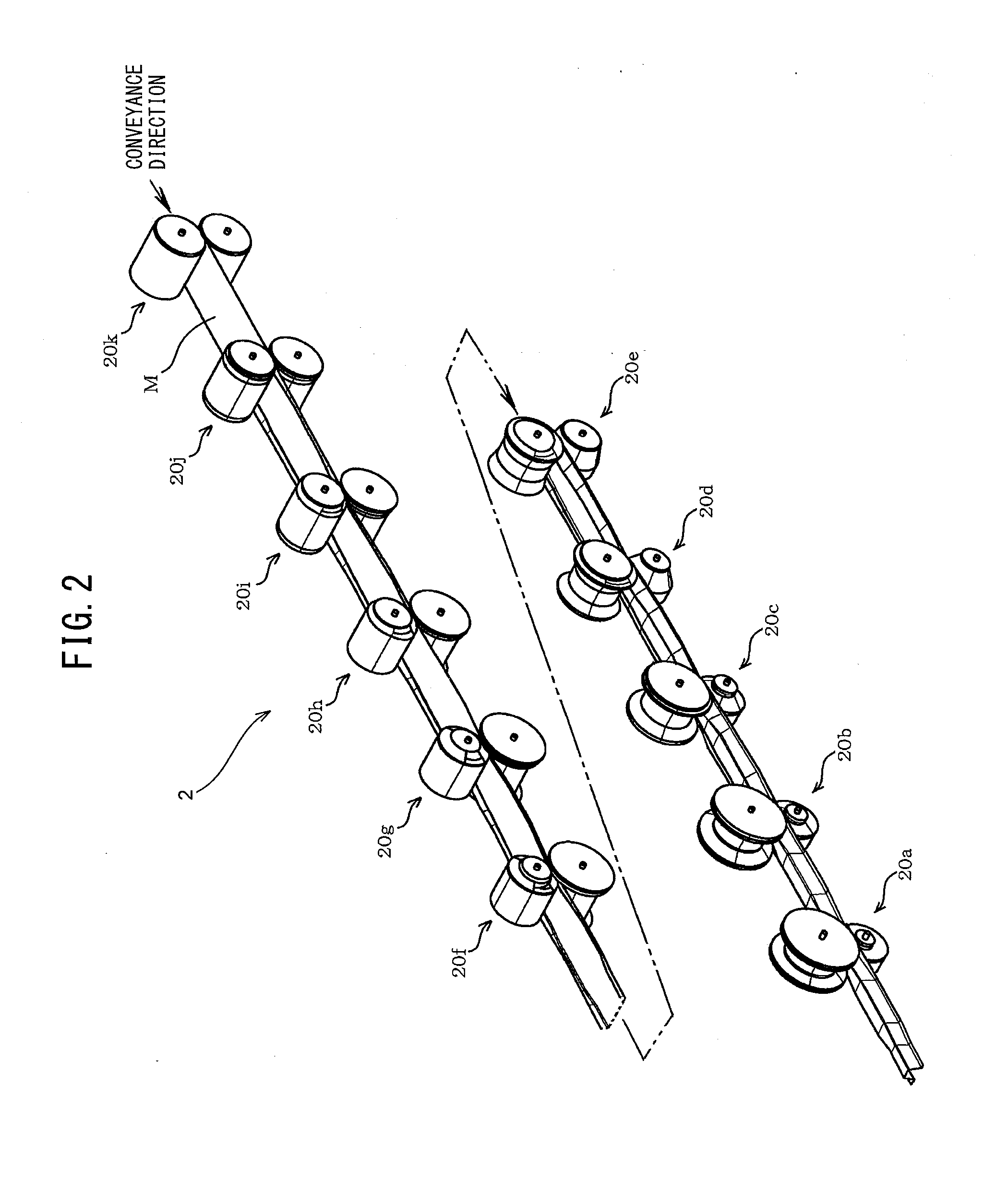Method of producing shaped steel changing in cross-sectional shape in longitudinal direction and roll forming apparatus for same
a technology of cross-sectional shape and rolling forming, which is applied in the field of method and roll forming for producing a shaped steel, can solve the problems of uneven springback due to high strength characteristics of steel materials, difficult to produce a hat-shaped steel as designed from such high tensile steel, and unsuitable roll forming, so as to prevent such interference, reduce the width of the cross-section, and eliminate the uneven springback
- Summary
- Abstract
- Description
- Claims
- Application Information
AI Technical Summary
Benefits of technology
Problems solved by technology
Method used
Image
Examples
first embodiment
[0062]First, the shaped steel produced in the present embodiment will be explained. The shaped steel which is shown in FIGS. 1A and 1B is one example of a hat-shaped steel of a saddle shape which varies in cross-sectional shape in the longitudinal direction (for example, the metal stock axis direction). FIG. 1A is a perspective view of the hat-shaped steel seen from the upper side, while FIG. 1B is a perspective view seen from the lower side. The hat-shaped steel 1 comprises a top wall, side walls which extend along the two side edge parts of the top wall, and flanges which extend along the edge parts at the opposite sides of the side walls, and has a cross-section vertical to the longitudinal direction of the hat-shaped steel 1 (lateral cross-section) which is substantially hat shaped.
[0063]The hat-shaped steel 1 further has ̂portions 10a, 10b having top wall width of L1, a portion 11 having top wall width of L2 (>L1), and tapered transition portions 12a and 12b having expanding (o...
second embodiment
[0096]Next, a modification of the rolling dies which are shown in the above-mentioned first embodiment will be explained. In the rolling dies of the present embodiment, as shown in FIG. 8, the outside diameter of the annular ridge part 33 of the bottom roll 3 (hatched part) and the outside diameter of the bottom surface of the annular groove part 42 of the top roll 4 (hatched part) are the same, and the side walls of the annular ridge part 33 of the bottom roll 3 are provided with the later explained relief. Leaving aside this feature, the top and bottom rolls 4 and 3 of the present embodiment are substantially the same as the top and bottom rolls 4 and 3 of the first embodiment. Similar component elements are assigned the same reference notations, and detailed explanations are omitted.
[0097]The relief which is provided at the side surfaces of the annular ridge part 33 of the bottom roll 3 will be explained in detail. FIG. 9 is a partial vertical cross-sectional view which is cut al...
third embodiment
[0126]FIG. 23A shows a hat-shaped steel 1 with a constant width and height but with a cross-section which moves in the lateral direction, while FIG. 23B shows the top and bottom rolls 4 and 3 which form the hat-shaped steel 1 of FIG. 23A by the final forming operation. That is, in the above first embodiment, a hat-shaped steel with a straight stock axis was produced, but in the present embodiment, a hat-shaped steel 1 with a stock axis which is curved in the width direction is produced. This hat-shaped steel 1 has portions 15a of a straight stock axis and portions 15b of a curved stock axis. As the rolls for this, as shown by the example in FIG. 23B, top and bottom rolls 4 and 3 which have an annular ridge part and annular groove part offset in the rotational axial direction are used. The overall configuration of the roll unit which drives rotation of the top and bottom rolls 4 and 3 can be configured in the same way as in the first embodiment.
[0127]According to the present embodime...
PUM
| Property | Measurement | Unit |
|---|---|---|
| tensile strength | aaaaa | aaaaa |
| tensile strengths | aaaaa | aaaaa |
| radius | aaaaa | aaaaa |
Abstract
Description
Claims
Application Information
 Login to View More
Login to View More - R&D
- Intellectual Property
- Life Sciences
- Materials
- Tech Scout
- Unparalleled Data Quality
- Higher Quality Content
- 60% Fewer Hallucinations
Browse by: Latest US Patents, China's latest patents, Technical Efficacy Thesaurus, Application Domain, Technology Topic, Popular Technical Reports.
© 2025 PatSnap. All rights reserved.Legal|Privacy policy|Modern Slavery Act Transparency Statement|Sitemap|About US| Contact US: help@patsnap.com



